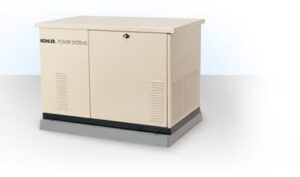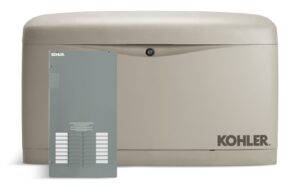In the Pacific Northwest, power outages are a relatively common occurrence. Windstorms blowing through the Columbia River Gorge, the occasional foot of snow, week-long icy weather, and aging infrastructure all contribute to lost power. As our climate changes, the proliferation of devastating fires has been on the rise as well.
Whether it’s a fallen branch, or a designed shutdown of a particular grid to prevent further damage, having backup power when you need it will keep vital aspects of your home or business up and running. Generators can be designed to keep an entire facility online or to ensure a few key applications stay in operation.
How do generators work?
Without getting into all of the moving parts of generator operation, they can be turned on manually or go into action automatically in the event of an unplanned outage. Backup or standby generators have an automatic transfer switch where the back-up power hooks into the utility power. The automatic transfer switch completely disconnects the utility power and connects to the generator power. This prevents back-feeding of the utility power grid.
When the utility power is interrupted, the transfer switch (1) is tripped, and backup power is provided where directed. When power has been reestablished, the transfer switch goes back to (2) a resting position so to speak. Depending on the age of the generator, there are exterior displays that allow you to check the status of the generator remotely. (1) The transfer switch transfers and (2) Normal utility position.
In some cases, powering the entire building doesn’t make sense. Relay modules allow you to route power to where it’s needed most, allowing non-essential areas to remain dormant. Although generators can be built to provide up to 4 megawatts of power, and several can be used together, relay modules allow you to conserve power when needed. control power to loads when needed.
Types of Generators
When choosing a generator, you’ll need to consider what you’ll be powering. A camper with appliances may not need much more than three of four thousand watts. A precast concrete plant that produces dry wells, manholes and other buried infrastructure will need much more mechanical energy to stay online.
Portable Generators
As the name implies, these generators are used for specific or planned outages. When no power is accessible (camping, new construction sites, etc.), these electrical generators can be used on-site and then removed when no longer needed. These are ideal for use on the road, when infrastructure isn’t currently in place, or when utilities are taken offline for maintenance or other services.
Standby Generators
These generators are meant to stay put, installed in place as part of the power infrastructure. In most cases, power outages aren’t planned, so standby generators are ready to go any time of day or night. Although they may be taken offline for maintenance or servicing.
Both generators run on gasoline, propane, or natural gas. If your home is already outfitted with natural gas, it can be tied directly into the generator. Diesel, Propane or Natural gas, gasoline isn’t available in standby generators because of EPA rules.
You’ll always want a little more power than you need at peak times. If you’re considering backup power installation, make sure to work with an electrical contractor with experience in generator sizing and installation. They’ll be able to determine how much power generation you’ll need.
Generator Installation
No two worksites are ever exactly the same. If you’re considering backup power installation, make sure to work with electrical contractors that have specific experience working with backup power and generators. You wouldn’t replace the electrical panel in your home for safety reasons alone. They can design the standby power system that best fits your needs.
The same goes for standby generators, especially when tying into a natural gas line if that’s an option. In addition to the safety factor, an experienced electrician will also know the most efficient spot to place the generator. In addition to those logistics, you’ll also want to consider noise and how exhaust systems are placed, especially in residential use.
Backup Power Maintenance
Just like any piece of machinery, generators need to be maintained. It’s just a matter of how often the back-up power is pressed into service. For example, you’ll probably want to service your camping generator at the start of every season, especially if gas was left in the tank during storage.
If your generator is backing up a 30,000 square foot industrial facility, you’ll want to be more consistent with your maintenance. Not being able to run a TV while tailgating is one thing. If backup power fails at a food processing plant, it could cost you tens of thousands of dollars in wasted product.
If the generator is run on gasoline or propane, keeping fuel tanks, fuel filters, and fuel supply lines clean will protect the rest of the generator, allowing it to perform at peak levels. Failing voltage regulators may not allow the proper passage of power, which could put the electrical systems of your facility and the generator itself at risk.
Work With Experience
The Prairie Electric backup power/generator department has more than three decades of experience. As a Kohler Installation and Service Dealer, we work on everything from small electric start backup power to generators weighing several tons, installations, and repair, our technicians receive constant training on newer technology to stay ahead of the generator game.
In addition to generator expertise, Prairie Electric also designs custom panels and automation boards, retrofits entire facilities to keep electrical systems up to code, tying new construction into existing power grids, and more. If you have a question about your residential, industrial or commercial power needs, reach out to Prairie Electric.


